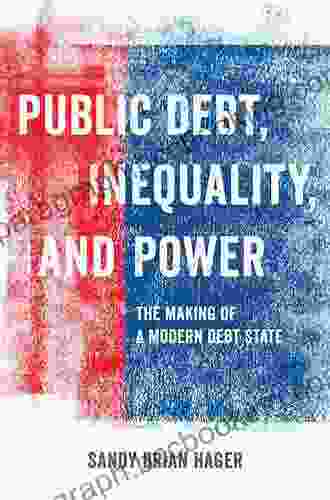Public Debt, Inequality, and Power: Unraveling the Interconnections

Public debt, inequality, and power are intertwined in a complex and often contentious relationship. Debts incurred by governments can have profound effects on the distribution of wealth and income, while the distribution of wealth and income can shape the way that governments borrow and spend. Power, in turn, can influence both the distribution of debt and the distribution of its effects.
The recent global financial crisis has brought the issue of public debt to the forefront of public policy debates. However, the relationship between public debt and inequality has long been a subject of study for economists and social scientists. In this article, we will explore the different ways in which public debt, inequality, and power are connected. We will also discuss the implications of these connections for public policy.
4.1 out of 5
| Language | : | English |
| File size | : | 10644 KB |
| Text-to-Speech | : | Enabled |
| Screen Reader | : | Supported |
| Enhanced typesetting | : | Enabled |
| Word Wise | : | Enabled |
| Print length | : | 176 pages |
| Lending | : | Enabled |
Public Debt and Inequality
There are a number of ways in which public debt can contribute to inequality. First, public debt can increase the cost of living for low- and middle-income households. When governments borrow money, they typically have to pay interest on that debt. This interest can be a significant burden for low- and middle-income households, who already spend a large portion of their income on basic necessities.
Second, public debt can lead to cuts in social programs. When governments need to reduce their spending, they often cut social programs, which provide essential services to low- and middle-income households. These cuts can have a devastating impact on those who rely on these programs, making it more difficult for them to make ends meet.
Third, public debt can contribute to inflation. When governments borrow money, they increase the supply of money in the economy. This can lead to inflation, which erodes the purchasing power of low- and middle-income households.
Inequality and Public Debt
Inequality can also contribute to public debt. When the gap between the rich and the poor is large, the wealthy are able to accumulate more assets, which can be used to Free Download government bonds. This can drive up the demand for government bonds, which can lead to higher interest rates. Higher interest rates can make it more difficult for governments to borrow money, which can lead to cuts in social programs and other essential services.
In addition, inequality can make it more difficult for governments to raise taxes. When the wealthy are able to avoid paying their fair share of taxes, the government has to borrow more money to make up the difference. This can lead to a vicious cycle of inequality and debt.
Power and Public Debt
Power also plays a role in the relationship between public debt and inequality. The wealthy and powerful are often able to influence government policy in their favor. For example, they may be able to push for tax cuts that benefit the wealthy, or they may be able to prevent cuts to social programs that benefit the poor. This can lead to policies that exacerbate inequality and increase public debt.
In addition, the wealthy and powerful can use their power to influence the way that public debt is used. For example, they may be able to push for policies that use public debt to fund tax cuts for the wealthy, or they may be able to prevent policies that use public debt to fund social programs for the poor. This can lead to policies that increase inequality and benefit the wealthy.
The relationship between public debt, inequality, and power is complex and often contentious. However, it is clear that these three factors are deeply interconnected. Public debt can contribute to inequality, inequality can contribute to public debt, and power can influence both the distribution of debt and the distribution of its effects.
The implications of these connections are significant for public policy. Policies that increase public debt, increase inequality, or increase the power of the wealthy are likely to have negative consequences for low- and middle-income households. On the other hand, policies that reduce public debt, reduce inequality, or reduce the power of the wealthy are likely to have positive consequences for low- and middle-income households.
It is important to note that there are no easy solutions to the problems of public debt, inequality, and power. However, by understanding the connections between these three factors, we can make better decisions about how to address them.
4.1 out of 5
| Language | : | English |
| File size | : | 10644 KB |
| Text-to-Speech | : | Enabled |
| Screen Reader | : | Supported |
| Enhanced typesetting | : | Enabled |
| Word Wise | : | Enabled |
| Print length | : | 176 pages |
| Lending | : | Enabled |
Do you want to contribute by writing guest posts on this blog?
Please contact us and send us a resume of previous articles that you have written.
 Book
Book Novel
Novel Page
Page Chapter
Chapter Text
Text Story
Story Genre
Genre Reader
Reader Library
Library Paperback
Paperback E-book
E-book Magazine
Magazine Newspaper
Newspaper Paragraph
Paragraph Sentence
Sentence Bookmark
Bookmark Shelf
Shelf Glossary
Glossary Bibliography
Bibliography Foreword
Foreword Preface
Preface Synopsis
Synopsis Annotation
Annotation Footnote
Footnote Manuscript
Manuscript Scroll
Scroll Codex
Codex Tome
Tome Bestseller
Bestseller Classics
Classics Library card
Library card Narrative
Narrative Biography
Biography Autobiography
Autobiography Memoir
Memoir Reference
Reference Encyclopedia
Encyclopedia Jose Vadi
Jose Vadi John P Davis
John P Davis Jon Mills
Jon Mills Josh Steimle
Josh Steimle Sugar Ray Leonard
Sugar Ray Leonard Jon Butler
Jon Butler John Mcenroe
John Mcenroe John Spangler
John Spangler Visual Arts
Visual Arts Joni Toikkanen
Joni Toikkanen John P Murphy
John P Murphy Pierce Brown
Pierce Brown Jonathan Yanez
Jonathan Yanez Josh Levine
Josh Levine Joseph Eleyinte
Joseph Eleyinte Josh Mckenzie
Josh Mckenzie Lesley Bielby
Lesley Bielby Jordannah Elizabeth
Jordannah Elizabeth Jonathan Tarbox
Jonathan Tarbox Joseph Bastianich
Joseph Bastianich
Light bulbAdvertise smarter! Our strategic ad space ensures maximum exposure. Reserve your spot today!

 Eliot FosterDiane Sawyer, Katie Couric, and Christiane Amanpour: Trailblazing Women in...
Eliot FosterDiane Sawyer, Katie Couric, and Christiane Amanpour: Trailblazing Women in...
 David PetersonUnlocking the Power of Emotional Safety: The Key to Raising Kids Who Live,...
David PetersonUnlocking the Power of Emotional Safety: The Key to Raising Kids Who Live,... Carson BlairFollow ·16.2k
Carson BlairFollow ·16.2k Mark TwainFollow ·12.2k
Mark TwainFollow ·12.2k Rick NelsonFollow ·2.9k
Rick NelsonFollow ·2.9k Colt SimmonsFollow ·14k
Colt SimmonsFollow ·14k Davion PowellFollow ·15.1k
Davion PowellFollow ·15.1k Jared NelsonFollow ·5k
Jared NelsonFollow ·5k Henry GreenFollow ·19.5k
Henry GreenFollow ·19.5k Duncan CoxFollow ·8.4k
Duncan CoxFollow ·8.4k

 Joseph Foster
Joseph FosterUnravel the Enigmatic Murders in "Pride and...
Dive into a World...

 Jeffery Bell
Jeffery BellTrauma-Focused CBT for Children and Adolescents: The...
Trauma is a...

 Jorge Luis Borges
Jorge Luis BorgesSense and Second Degree Murder: A Jane Austen Murder...
Prepare yourself for a...

 Chase Simmons
Chase SimmonsUnleash the Vibrant World of Watercolor: An Enchanting...
In the world of art, watercolor painting...

 Rubén Darío
Rubén DaríoAmerican Funny Animal Comics In The 20th Century: A...
Step into a bygone era of laughter and...
4.1 out of 5
| Language | : | English |
| File size | : | 10644 KB |
| Text-to-Speech | : | Enabled |
| Screen Reader | : | Supported |
| Enhanced typesetting | : | Enabled |
| Word Wise | : | Enabled |
| Print length | : | 176 pages |
| Lending | : | Enabled |










